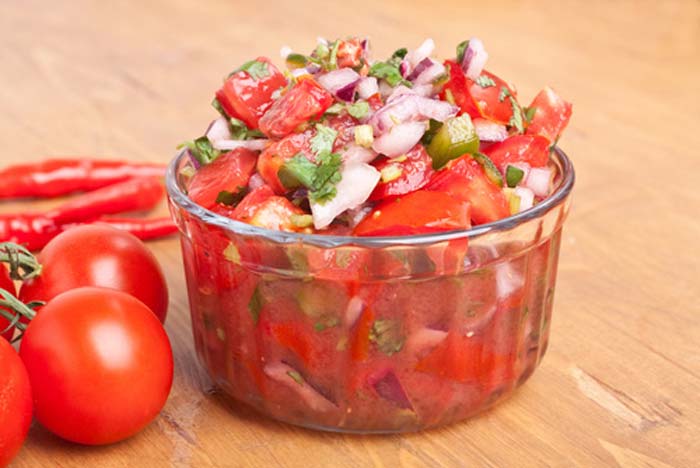When it comes to type 2 diabetes and prediabetes, foods often raise questions. Since you’re here, you’re obviously wondering, “Is salsa good for someone like me?”
The short answer is: Yes! Salsa can be a flavorful diabetes-friendly addition to your weekly meal plan. But like anything, it depends on the ingredients and how you use it.
Here, you’ll learn why salsa is a great choice, what to watch out for, and how to incorporate it into your eating plan to support optimal blood sugar control.
Why Salsa Is a Diabetes-Friendly Food
Salsa, at its core, is a mix of nutrient-dense vegetables and herbs like tomatoes, onions, peppers, and cilantro.
These ingredients provide essential vitamins, minerals and antioxidants while being naturally low in carbohydrates and calories.
Here’s a closer look at what makes salsa a great option:
- Low in Carbohydrates: Most salsas contain minimal carbohydrates because they’re primarily made from non-starchy vegetables. A 2-tablespoon serving of traditional tomato-based salsa has about 2 grams of carbs and just 10 calories. Keeping your carb intake low is essential for managing blood sugar, as fewer carbs reduce the chances of post-meal glucose spikes.
- Rich in Nutrients:
- Tomatoes: Packed with vitamin C, potassium, and lycopene (a powerful antioxidant), tomatoes in salsa support heart health and may help reduce inflammation—common concerns when you have diabetes.
- Peppers: Whether mild or spicy, peppers are loaded with vitamin C and capsaicin, which has been linked to improved insulin sensitivity.
- Onions: A source of quercetin and thiosulfinides, which are beneficial plant compounds that may help lower blood sugar levels.
- Low Glycemic Index (GI): Salsa ingredients generally have a low GI, meaning they cause slower and steadier blood sugar rises. The GI of tomatoes, for example, is around 15, which is considered very low. This makes salsa a safer choice compared to high-GI condiments like ketchup or sugary sauces.
- Supports Weight Management: For people with type 2 diabetes or prediabetes, maintaining a healthy weight is key to better blood sugar control. Salsa is naturally low in calories, making it an excellent way to add flavor without adding extra calories.

What to Watch Out For in Store-Bought Salsa
Many store-bought salsas will be perfectly fine to eat. But like any store-bought food, not all salsas are created equal.
It’s always best to read food labels for, checking the ingredients and nutrition facts. Here’s what to look for:
- Added Sugars Some salsas sneak in sugar to enhance flavor, which can increase the carb content significantly. Always check the label for “added sugars” or ingredients like high-fructose corn syrup. Preferable, aim for salsa with 1 grams or less of sugar per serving. Most salsas will fit into this category.
- Sodium Content Many pre-packaged salsas are high in added salt, which raises the sodium content, with some brands containing over 200 milligrams sodium per serving. Excessive sodium intake can contribute to high blood pressure, a common concern for people with diabetes. There are many brands with sodium under 200 milligrams, so choose those over others.
- Unhealthy Oils or Preservatives Some salsas contain added oils or preservatives that provide no nutritional benefit. Stick to options with whole, simple ingredients.
Making Diabetes-Friendly Salsa at Home
Homemade salsa is one of the best ways to ensure you’re getting a healthy, nutrient-rich condiment.

Here’s a quick and simple recipe:
Homemade Salsa
- Ingredients:
- Instructions:
- Combine all ingredients in a bowl.
- Stir well and let it sit for 10–15 minutes to allow the flavors to meld.
- Serve fresh or refrigerate for up to 3 days.
This salsa contains no added sugars, minimal sodium, and just 4 grams of carbs per 1/4 cup serving.
With homemade salsa you can really get creative with the ingredients as well—try adding diced avocado for creaminess, finely chopped cucumber for a refreshing crunch, fresh herbs like parsley for a different flavor profile, or a pinch of smoked paprika for added depth.
How to Incorporate Salsa Into a Diabetes-Friendly Diet
You want to avoid eating salsa with corn chips, as that’s a sure way to spike blood sugar levels.
Instead, use salsa to enhance the flavor of your meals without adding unnecessary carbs or calories.
Here are a few diabetes-friendly ways to use it:
- Top Lean Proteins: Use salsa as a topping for grilled chicken, fish or turkey burgers. It adds moisture and flavor without relying on sugary sauces.
- Replace High-Carb Sauces: Swap out ketchup, barbecue sauce, or creamy dressings for salsa. This simple change can save you significant carbs and sugar.
- Pair With Low Carb Snacks: Instead of traditional tortilla chips, try salsa with raw vegetables like cucumber slices, bell pepper strips, or celery sticks for a crunchy almost carb free snack.
- Add to Omelets or Scrambled Eggs: A dollop of salsa can transform your breakfast, adding a burst of flavor without carbs.
- Mix Into Cauliflower Rice or Salads: Stirring salsa into cauliflower rice or using it as a salad dressing alternative can liven up these healthy staples.
- Top Your Tacos: Tacos can be a delicious diabetes-friendly meal and salsa makes the perfect topping, especially when combined with sour cream!
Conclusion: Salsa Is a Healthy Choice for Diabetes
Salsa, when made with fresh, whole ingredients, is an excellent addition to your diabetes-friendly diet.
Its low carb content, rich nutrients, and versatility make it a flavorful way to support healthy blood sugar levels while enjoying your meals.
Store-bought salsa is also a good choice. If you’re buying salsa, always check the label for added sugars and excess sodium—there are lots of options.
Of course, whipping up a quick batch at home is ideal, for maximum freshness and control over the ingredients.
Either way, you can feel confident in your choice to eat salsa—it is a diabetes-friendly food!

beverly saul
Thank you-LOVE salsa happy to see that it is still on the list for my prediabetes diet.